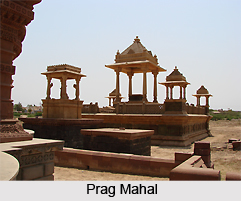 Guru Gorakhnath Temple in the hills of Dhinodhar is located in Nakhatrana taluka near the main city of Bhuj. It is about 1000 feet high. The hill is basically famous for the Guru Gorakhnath temple, situated on the top of the hill. The hill is about 7 miles from the town of Nakhatrana. The temple belongs to the Nath Sampraday, who is staunch follower of Guru Gorakhnath which was established in 644 A.D.
Guru Gorakhnath Temple in the hills of Dhinodhar is located in Nakhatrana taluka near the main city of Bhuj. It is about 1000 feet high. The hill is basically famous for the Guru Gorakhnath temple, situated on the top of the hill. The hill is about 7 miles from the town of Nakhatrana. The temple belongs to the Nath Sampraday, who is staunch follower of Guru Gorakhnath which was established in 644 A.D.
The Guru Gorakhnath Temple architecture is quite ancient, around 1200 years old. Not much is known about the constructor of the temple, the original one being heavily damaged by the devastating earthquake of 1819 AD. Gorakhnath Temple was subsequently revived in 1821 by Sunderjee Khatri, a rich merchant residing in Bhuj. The statue of the Guru is about 3 feet in height, made of an unusual type of black marble. There is a small deep (oil lamp) that is always kept lighted since the temple`s birth. A fireplace is also seen nearby the temple, believed to be the very one used by Guru Gorakhnath himself, for his pujas. People strongly believe that, by offering puja in the revered Guru`s feet, their wishes shall be fulfilled. The temple still looks majestic in its own shine and glory, even after so many years of its being built. An enormous fair is held every year in the month of October, on the birthday of Guru Gorkhnath, taking up the footfall to few lakhs.
The Guru Gorakhnath Temple is well connected from major towns like Bhuj, Ahmedabad and Surat. However, the uphill trudge is not very flowery, as the roads are still underdeveloped. A Dharamshala is present, but with bare minimum facilities. The Gujarat Government is taking initiative finally, to deck up the Guru Gorakhnath temple complex into a tourist hub.





















